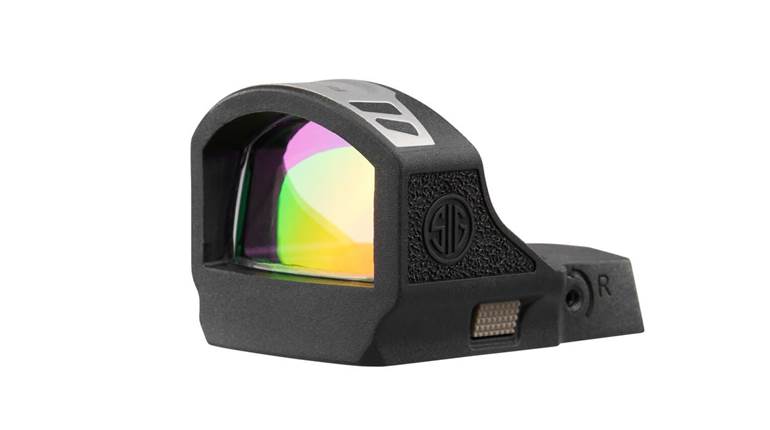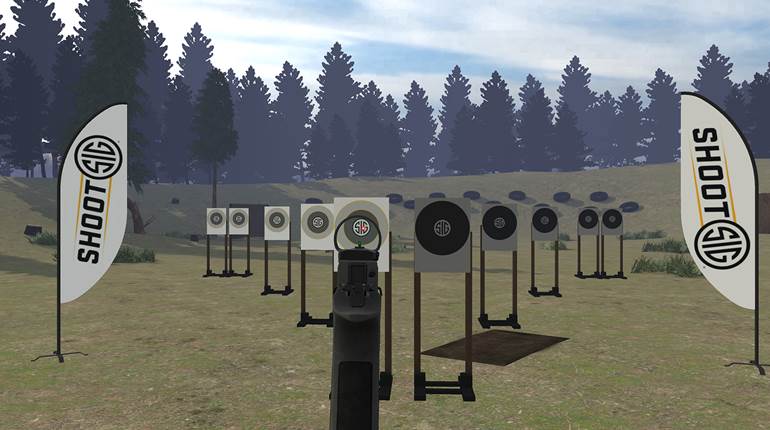
The patented V-Crown jacketed hollow-point is the key to SIG Sauer’s Elite Performance Ammunition. Shown here are (l. to r.): .380 ACP (90 gr.), 9 mm Luger (124 gr.), .357 SIG (125 gr.), .40 S&W (165 gr.) and .45 ACP (200 gr.). Training loads with full-metal-jacketed bullets are also available from SIG. Note the .40 S&W load’s nearly 14" of penetration in 10 percent ordnance gelatin (below).

These days, it seems there is no shortage of quality defensive ammunition offerings from a few well-known—and many lesser-known—manufacturers. More and more, though, firearm manufacturers are getting into the ammunition business, leveraging their brands in the minds of consumers who have already come to trust their products. There may be no better example than SIG Sauer, a gunmaker known worldwide for its semi-automatic pistols, carbines and precision rifles.
SIG Sauer, which is headquartered in New Hampshire, decided to broaden its presence by acquiring or otherwise developing not only optics and suppressor lines but an ammunition line as well. Regarding the latter, which was introduced last year, I spoke with SIG Sauer’s vice president of marketing, Bud Fini, to find out what led to the company’s introduction of a new line of defensive handgun loads, dubbed Elite Performance Ammunition—especially considering that the market seems to already be a very crowded one.
According to Fini, one of the major drivers was to create specific loads designed to function particularly well in the company’s own pistols. “As manufacturers of handguns and rifles shooting millions of rounds per year, we now have the ability to tailor ammunition that will perform better in SIG firearms as well as competitive offerings. We believe our new V-Crown patented design offers exceptional performance in a non-bonded bullet, and Ducta-Bright 7A-coated brass cases significantly aid feeding and extraction. Together, they make what we think is the ultimate defensive round, delivering exceptional on-target energy, maximum weight retention and optimal expansion at all effective distances.”
 SIG Sauer acquired an existing ammunition-production facility in Kentucky, Fini told me, and staffed it with SIG Sauer employees to produce and load all current ammunition offerings there. In fact, given how well the product has been received thus far, he indicated that the company intends to eventually relocate to a new larger facility.
SIG Sauer acquired an existing ammunition-production facility in Kentucky, Fini told me, and staffed it with SIG Sauer employees to produce and load all current ammunition offerings there. In fact, given how well the product has been received thus far, he indicated that the company intends to eventually relocate to a new larger facility.
Fini talked about the design goals of the new ammunition: “Improved reliability and feeding, along with better penetration with regard to barriers such as clothing, plywood, wallboard, etc.,” he said, adding, “Ultimately, controlled expansion with superior penetration is the goal in being able to deliver maximum on-target energy.”
To attain those goals, SIG Sauer designed a “stacked hollow-point” bullet with an additional hollow-point cavity and a unique, toothed cannelure halfway up the shank to ensure terminal expansion. Also, V-shaped jacket skives and scores are intended to allow the bullet to expand in a controlled, uniform manner.
The case coating is said to provide “enhanced lubricity, superior corrosion resistance, and reliable feeding and extraction.” In addition, given that the loads are intended for use in self-defense situations, which typically take place in low-light conditions, the loads use a low-flash propellant designed to preserve the user’s night vision.
Knowing that the FBI Protocol testing has become something of a gold standard with regard to defensive ammunition testing, I asked Fini if SIG Sauer will attempt to be a player in the law-enforcement market with its new loads. “Initially, our intention was to concentrate specifically on the commercial market, but two scenarios have come into play. First, the current shortages of certain calibers and types have opened markets of opportunity in which we didn’t think we were ready to engage at such an early point in the business’s development. Second, some agencies are changing their thoughts on bonded versus non-bonded bullets.”
Fini said the company will introduce bonded bullets in the future, but he added that SIG Sauer’s position is that a high-quality jacketed hollow-point is better-suited for many situations when penetration through glass is not a requirement. Given that, Fini said, “So, no, we will not be a major player in the overall law-enforcement market, but we are currently selling to agencies that prefer our bullet design, and will do so wherever the demand is apparent.”
Fini said the new SIG-designed V-Crown bullet features a gliding metal jacket covering a core consisting of a proprietary lead alloy whose metallurgical composition is projectile/caliber-dependent. With regard to the actual construction of the projectile, Fini said, “With the exception of the .380 ACP, all projectiles utilize a mechanical jacket-to-core locking feature. In addition, our unique method of skiving is designed to stop projectile expansion before separation can occur.”
As to the company’s goals for penetration through various media, Fini said, “The FBI barrier test, per the most recent Department of Justice Requests for Proposal, scores a projectile based on five performance measures: Average depth of penetration; consistency of penetration depth; percentage of retained weight; expansion; and percentage of shots that penetrate less than a specified minimum. Points are allocated differently for each of the five performance measures. Our design goal was to maximize the overall score. For the most part, this means that we chose to maximize the weight retention of our projectiles and have them expand to the greatest extent possible while still meeting the minimum penetration requirement.”
SIG Sauer chose to launch its brand by initially offering loads in the most popular personal-defense chamberings, and appears to be off to a great start. Fini told me “Each additional load offering within a given caliber will feature a different weight projectile and will be tailored for a particular purpose. Load offerings featuring a light-for-caliber projectile will be optimized for short barrel/pocket/concealed carry pistols, and load offerings featuring a heavy-for-caliber projectile (with inherently subsonic velocities) will be designed with suppressor-friendliness in mind.”
I was able to shoot five of the first handgun loadings—.380 ACP, 9 mm Luger, .357 SIG, .40 S&W and .45 ACP—for accuracy and velocity, and you can see the results in the accompanying table on p. 43. Each load was also fired into 10 percent ordnance gelatin covered with two layers of denim and measured for penetration in the gel block as well as final expanded diameter of the recovered bullets. In all of my testing, there was only one hiccup, and that was a single failure to feed with the 90-gr., .380 ACP load through a Diamondback DB380. In short, I was impressed on all fronts by SIG’s defensive ammunition.
Since my initial testing, SIG Sauer has added to the V-Crown line with two more 9 mm Luger loads (115 and 147 grs.), a .38 Super +P (125 grs.), a 10 mm Auto (180 grs.) and two .45 ACPs (185 and 230 grs.). Revolver cartridges have also been introduced, and include .38 Spl. (125 grs.), .357 Mag. (125 grs.), .44 Spl. (240 grs.), .44 Mag. (240 grs.) and .45 Colt (230 grs.). There are also full-metal-jacket loads in .380 ACP (100 grs.), .38 Spl. (125 grs.), 9 mm Luger (115 grs.), .38 Super (125 grs.), .357 SIG (124 grs.), .357 Mag. (125 grs.), .40 S&W (180 grs.), 10 mm Auto (180 grs.) and .45 ACP (230 grs.).
Last year, Fini told me “Rifle calibers are also in the works.” And the first one—.300 Blackout—is already shipping. The two available loads are a 125-gr. supersonic and a 220-gr. subsonic—both with Open Tip Match bullets.
If SIG Sauer makes good on its promises to ramp up the number of its new offerings and continues to apply its considerable assets to the quality and consistency of their manufacture, the familiar “SIG” lettering on ammunition boxes could conceivably achieve the same level of reverence in consumers’ minds as it does on SIG firearms—and that would be quite an accomplishment.

For more information, contact SIG Sauer (866) 345-6744; sigsauer.com






































